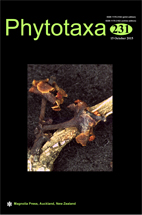Abstract
Tetrapyrgos (Basidiomycota, Agaricales) is recognized as a genus characterized by basidiomes with a central or eccentric, well-developed stipe with a black to bluish black stipe base arising from a basal pad or disc; hyaline, inamyloid, distinctly tetrahedral basidiospores; non-gelatinous or weakly gelatinous pileipellis and pileus tramal tissues; and apically bulbous cheilocystidia with diverticulate central axis. It is distinguished from Campanella, which has basidiomes that are sessile or with a pseudostipe that lacks black or bluish black pigmentation, and does not arise from a pad or basal disc; basidiospores ellipsoid or bulging slightly on one side; strongly gelatinous pileipellis and pileus tramal tissues; and cheilocystidia typically with central portion of axis non-diverticulate. Analyses and taxonomic status of 16 species placed in Tetrapyrgos (and their reported synonyms) are provided, based on examinations of 80 recently collected specimens and 85 exsiccata. Nine species are recognized here in Tetrapyrgos, supported by morphological and molecular data, including two new species, T. longicystidiata and T. parvispora. The remaining 7 species are recognized as belonging in Campanella or are of uncertain taxonomic placement. Comprehensive descriptions for all accepted species, type studies, and phylogenetic inferences derived from ITS analyses are provided.

